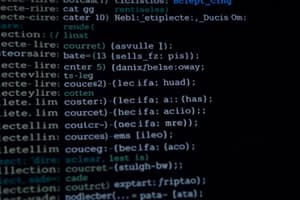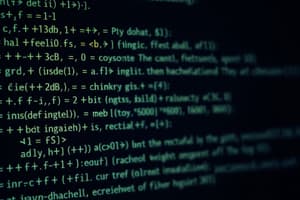Podcast
Questions and Answers
Which of the following best describes the core principle behind recursion in computer science?
Which of the following best describes the core principle behind recursion in computer science?
- Using loops to repeatedly execute a block of code until a condition is met.
- Utilizing external libraries to handle complex mathematical operations.
- Solving a problem by breaking it down into smaller, self-similar subproblems. (correct)
- Employing conditional statements to avoid repetitive function calls.
In programming, what is the primary mechanism by which a recursive process repeats its execution?
In programming, what is the primary mechanism by which a recursive process repeats its execution?
- By automatically resetting the program counter to the beginning of the function.
- Via a procedure calling itself until a terminating condition is satisfied. (correct)
- By utilizing a separate function to manage iterations.
- Through the explicit use of `for` or `while` loops.
What is a key advantage of using recursion for problem-solving?
What is a key advantage of using recursion for problem-solving?
- Recursion always results in faster execution times compared to iterative solutions.
- Recursion simplifies problem-solving by utilizing global variables exclusively.
- Recursion eliminates the need for error handling and debugging.
- Recursion can break down complex problems into more manageable, smaller subtasks. (correct)
Which statement accurately compares recursion and iteration as problem-solving approaches?
Which statement accurately compares recursion and iteration as problem-solving approaches?
What is the most important consideration when designing a recursive function to ensure it terminates correctly?
What is the most important consideration when designing a recursive function to ensure it terminates correctly?
Flashcards
Recursion
Recursion
A problem-solving approach where the solution depends on solutions to smaller instances of the same problem.
Recursion in Programming
Recursion in Programming
In programming, when a procedure calls itself until a terminating condition is met.
Recursion vs. Iteration
Recursion vs. Iteration
Recursion achieves repetition without using loops, breaking problems into smaller, self-similar subtasks.
Terminating Condition
Terminating Condition
Signup and view all the flashcards
Recursive <-> Iterative Equivalence
Recursive <-> Iterative Equivalence
Signup and view all the flashcards
Study Notes
- Recursion represents a specific approach to problem-solving in computer science.
- Recursive solutions depend on solutions to smaller instances of the same problem.
- In programming, recursion occurs when procedure calls itself until a terminating conditions are met.
- No specific repetition construct is required, such as "while" or "for" loops, to accomplish recursion.
- Recursion breaks down problems into smaller subtasks.
- Algorithms presented recursively can often be presented in an iterative manner, and vice versa.
Features of Stack ADT
- Stacks consist of a "chain" of data.
- Data is "pushed" onto the top.
- Data is "popped" from the top.
- Stacks follow the LIFO (last in, first out) approach.
- Error is caused when trying to access an element from an empty stack; avoid this.
Features of Queue ADT
- Queues are made of a "chain" of data.
- Elements are "enqueued" at the back.
- Elements are "dequeued" from the front.
- Queues follow the FIFO (first in, first out) approach.
- Avoid accessing elements from an empty queue to prevent errors.
Features of Binary Tree ADT
- Trees have nodes with two pointers.
- One pointer leads to smaller elements located to the left, and another to larger elements located to the right.
- Trees assemble themselves from the root node.
- The root node usually holds the middle value of the whole set in a balanced tree.
- Binary trees are naturally sorted.
- Searching is done in a binary manner.
- Standards and conventions help people function and collaborate at an international level with ease.
- Traffic light conventions require vehicles to stop at red lights and proceed with caution at amber lights.
- This international standard enables people to drive anywhere in the world without issues.
- Height measurements do not follow a single international convention, with some using the metric system and others using feet and inches.
- Disparities in international convention causes difficulties in understanding and communication.
- Road-driving customs are deeply embedded in local cultures and difficult to change.
- Most countries drive on the right-hand side, while others drive on the left.
- Varied driving conventions increases economic costs for the car industry, causing difficulties when switching between the two.
- International conventions are important for enabling communication and collaboration across the globe.
- Programming has its own conventions to allow people to exchange and work around projects.
- Following coding conventions also reduces costs, especially during software maintenance.
- Most of the cost of software is taken up by maintenance, often by someone other than the original author, leading to code conventions to ensure readability.
- Code following internationally established conventions becomes easier and less costly to maintain.
Coding Conventions
- Language conventions employ the English language in programming (except for some educational languages).
- Comment conventions use block or line comments.
- Block comments in Java are delimited, can span multiple lines.
- Line comments in Java are delimited by //.
- Comments should summarize code in the best way as subject to dispute.
Studying That Suits You
Use AI to generate personalized quizzes and flashcards to suit your learning preferences.




